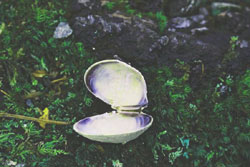 Endurance? Indian pythons have been known to copulate for an amazing 180 days. Compare that with bulls of some species that can only keep it up for one second!
Endurance? Indian pythons have been known to copulate for an amazing 180 days. Compare that with bulls of some species that can only keep it up for one second!
Sadomasochism? Roman snails actually shoot love darts at each other just to figure out whether they belong to the same species (the female's vagina is in her head!). As for the female praying mantis, she has her male and eats him too!
Desperate inventiveness? Using a sharp-tipped penis, the male bedbug must drill an artificial receptacle into his female because she is born without a vagina.
Group sex? Bull frogs with prospective females in a pond orgy.
Sex change? Female cleaner fish (blue and striped-black) do it all the time, turning a bright yellow in the process. Oysters not only change sex frequently, but can impregnate and be impregnated just one week apart.
Bondage? Male and female hornbills cooperate to imprison the female, who will be let out of her nest-prison only after she has delivered and helped rear their offspring!
Gorgy? When the times comes to mate, the female land tortoise will eat so much that when she pulls her head into her shell, her vagina pops out, signalling her willingness to mate!
Ouch! The octopus female has a vagina in her nose. If a male tries to mate with her against her will she simply bites off his penis and makes off with it (he has eight)!
Explore habits and preferences across species!
Damselflies
Not too much preliminary courtship here! Often seen near ponds and streams flying in tandem, the male overtakes the female in flight, landing on her back and grabbing hold of her thorax with claspers located at the end of the abdomen. She remains in his grasp until she lays her eggs. While in his grip the female twists herself around until mating takes place.
Nilgiri Tahr
Evolutionary links between primitive goat antelopes and true goats, male Nilgiri tahr usually disassociate from females except during the breeding season between June and September. Males fight with each other for the honour of mounting females of their choice, by crashing their horns into each other and charging into each other's flanks. Females have the ability to quickly conceive again, if a young one dies.
Lions
 Though lions are looked upon as symbols of virility across the world, the truth is that the sexual act is over within a minute! However, lions may mate repeatedly within a short span of time. Typical of cats, the lion grabs the lioness by the neck, often drawing blood in the process. The act is accompanied by continuous low growls by the lion and higher pitched mewing sounds from the lioness.
Though lions are looked upon as symbols of virility across the world, the truth is that the sexual act is over within a minute! However, lions may mate repeatedly within a short span of time. Typical of cats, the lion grabs the lioness by the neck, often drawing blood in the process. The act is accompanied by continuous low growls by the lion and higher pitched mewing sounds from the lioness.
Muggers
The breeding season of muggers depends to a great extent on suitable water levels, temperature and food availability. Mating is marked by complicated rituals that may involve bubble-blowing, circling and head and neck displays. In the breeding season disputes over females and territories may result in serious, sometimes fatal injuries.
Dholes
Dholes become sexually mature when they are a year old. Olfactory senses are key to their mating rituals, which involve spraying of pheromones through urine marking by the males and detection of oestrus in females. Known as the whistling hunters, the vocal repertoire of dholes has not been fully described, though field biologists suggest they have a sophisticated language. Pups are normally dropped in winter after a gestation period of 63 days. Breeding is believed to be restricted to one female in the pack, but the entire pack adopts the cubs and protects them.
Robber flies
The courtship behaviour of the robber flies has not been well studied. But we know that males use short aerial investigations to locate a female who will be snatched from the air. Some take courtship into the realm of exhibitionism and hover before females, legs extended, to display prominent tarsi, brandishing the abdomen before the potential mate. The mating position is generally tail to tail, or with male and female facing angularly in the same direction.
Atlas moths
The world's largest moth, with a wingspan of almost 300 mm. Both sexes live for only a day after emerging from their cocoons. But in that one day, they have nothing on their minds but sex! The males find females using antennae that pick up even the faintest traces of the female's pheromones (which she brushes through the air by fluttering her wings over scent glands on her abdomen) at distances exceeding four kilometres. Within hours of mating, the lovers die, but not before the female lays her eggs.
Elephants
b>Lions
 Elephants are long-lived and males may court females for up to three years before being allowed to mate. In the process a male may protect and help feed the female by sharing food sources. Elephants use their trunks to detect signs of willingness to mate in females. Their scent is carried to great distances through the air. Males use the trunk to caress, nudge and otherwise reassure females, without whose cooperation sex is understandably impossible.
Elephants are long-lived and males may court females for up to three years before being allowed to mate. In the process a male may protect and help feed the female by sharing food sources. Elephants use their trunks to detect signs of willingness to mate in females. Their scent is carried to great distances through the air. Males use the trunk to caress, nudge and otherwise reassure females, without whose cooperation sex is understandably impossible.
Spoonbills
Spoonbills, like all birds that occupy heronries, indulge in group sex in that they often copulate cheek-by-jowl with hundreds of other birds. Like nesting spots, mating spots too are carefully chosen as their perches must bear the weight of both heavy birds. In the breeding season (monsoon) both sexes display a lemon-coloured nuchal crest at the back of their heads.
Frogs & Toads
Sex often takes place at night, away from the eye of predators. Males serenade females at the first sign of rain, when their croaks and clicks fill the air. The air sacs on either side of the mouth amplify sound that may be heard up to two kilometres away. Females may remain in the male's clasp for hours in an embrace known as amplexus. The female will not copulate till the next breeding season.
 Endurance? Indian pythons have been known to copulate for an amazing 180 days. Compare that with bulls of some species that can only keep it up for one second!
Endurance? Indian pythons have been known to copulate for an amazing 180 days. Compare that with bulls of some species that can only keep it up for one second! 
 Though lions are looked upon as symbols of virility across the world, the truth is that the sexual act is over within a minute! However, lions may mate repeatedly within a short span of time. Typical of cats, the lion grabs the lioness by the neck, often drawing blood in the process. The act is accompanied by continuous low growls by the lion and higher pitched mewing sounds from the lioness.
Though lions are looked upon as symbols of virility across the world, the truth is that the sexual act is over within a minute! However, lions may mate repeatedly within a short span of time. Typical of cats, the lion grabs the lioness by the neck, often drawing blood in the process. The act is accompanied by continuous low growls by the lion and higher pitched mewing sounds from the lioness. Elephants are long-lived and males may court females for up to three years before being allowed to mate. In the process a male may protect and help feed the female by sharing food sources. Elephants use their trunks to detect signs of willingness to mate in females. Their scent is carried to great distances through the air. Males use the trunk to caress, nudge and otherwise reassure females, without whose cooperation sex is understandably impossible.
Elephants are long-lived and males may court females for up to three years before being allowed to mate. In the process a male may protect and help feed the female by sharing food sources. Elephants use their trunks to detect signs of willingness to mate in females. Their scent is carried to great distances through the air. Males use the trunk to caress, nudge and otherwise reassure females, without whose cooperation sex is understandably impossible.